Overview
The Securities and Exchange Commission (SEC) settled with 181 defendants in the third calendar quarter of 2009, compared to 160 in the previous quarter and 216 in the third quarter of 2008. With the end of the third quarter of 2009, the SEC's 2009 fiscal year came to a close. In its 2009 fiscal year ("FY 2009"), the SEC settled with 626 defendants, compared to 673 in fiscal year 2008.1 In this paper, we examine recent trends in SEC settlements, including a comparison of settlements with public companies versus settlements with individuals, an issue brought to the forefront by the recent rejection of the SEC's proposed settlement with Bank of America.
Settlement Activity
Six settlements in the third quarter exceeded $10 million, topped by the $50 million settlement with General Electric for alleged financial misstatements in 2002 and 2003.2 The 10 largest settlements of the third quarter of 2009 are detailed in Exhibit 1.
The allegations against General Electric included a $585 million overstatement of the company's 2002 net earnings relating to accounting practices for aircraft parts sales, avoidance of a $200 million pre-tax charge to earnings due to accounting practices for the company's commercial paper, acceleration of revenue recognition relating to $370 million of locomotive sales in 2002 and 2003, and improper accounting for interest-rate swaps.3
The second-largest amount of the quarter was the $29.8 million summary judgment award against James Duncan for his role in running an affinity fraud that took the form of a "Ponzi-like scheme."4,5 According to the SEC, Mr. Duncan, along with codefendants Hendrix Montecastro and Maurice McLeod, targeted members of the Southern California Filipino community, fellow church members, and military personnel.
The third-ranking settlement was the $18.3 million settlement with AGCO Corporation for an alleged violation of the Foreign Corrupt Practices Act (FCPA). AGCO, a manufacturer of agricultural equipment, is alleged to have paid $5.9 million in bribes to Iraqi officials over the period 2000 – 2003 in exchange for contracts under the UN Oil-for-Food program.
Exhibit 1. Ten Largest SEC Settlements In The Third Quarter Of 2009
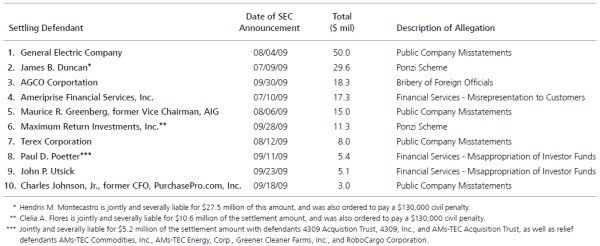
Trends In The Number Of Settlements
The number of settling defendants declined to 626 for FY 2009, the second consecutive year of decline and the lowest annual number of settling defendants since the Sarbanes-Oxley Act ("SOX") (Exhibit 2). However, there are important caveats to this observation. First, this has been a year of transition and staff turnover at the SEC, including in the top positions. Notably, the agency has a new Chairman, Mary Schapiro, and a new director of enforcement, Robert Khuzami. Further, many of the cases settled in FY 2009 were likely the result of investigations opened in earlier years.6
Trends In Settlement Values
Monetary payments were a component of 58.6% of company settlements and 58.9% of individual settlements in FY 2009. Among companies whose settlements included a monetary payment, the average settlement was $10.7 million, compared to $4.7 million in the previous year (Exhibit 3). On the other hand, the median company settlement amount, i.e., the settlement amount with an equal number of values above and below it, was $1.0 million, equal to the median from the previous year. An important reason that the average settlement increased markedly while the median remained constant is that there were three FY 2009 settlements for over $100 million: the $350 million settlement with Siemens for alleged violations of the FCPA, the $200 million settlement with UBS for allegedly facilitating customer tax evasion, and the $177 million settlement with Halliburton and its subsidiary KBR for alleged FCPA violations. In contrast, the largest settlement in FY 2008 was the $37.4 million settlement with Ritchie Capital Management for alleged late trading. Removing settlements in excess of $100 million reduces the FY 2009 average company settlement amount to $4.4 million.
The average settlement with individual defendants was $1.0 million for the fiscal year, compared to $1.2 million in the prior year. The median settlement was $0.1 million for individuals in the second quarter, as it has been in every fiscal year since SOX.
Exhibit 2. The Number Of Settling Defendants Declined For The Second Straight Fiscal Year
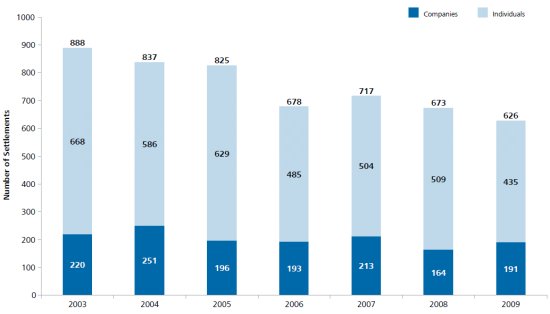
Exhibit 3. The Average Company Settlement Amount Increased In 2009, But The Median Held Steady
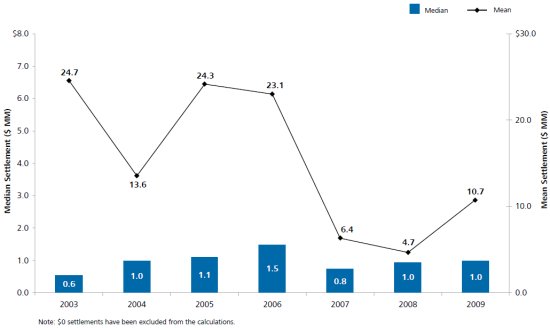
The Proposed Bank Of America Settlement
Had the $33 million proposed settlement with Bank of America not been struck down in federal court, it would have counted as the second-largest settlement in the quarter. In that case, the SEC has accused Bank of America of inadequate disclosures of provisions for bonus compensation to Merrill Lynch employees in proxy documents sent to shareholders of both firms before a vote on the Merrill acquisition.
Finding that the proposed settlement "[did] not comport with the most elementary notions of justice and morality, in that it proposes that the shareholders who were the victims of the Bank's alleged misconduct now pay the penalty for that misconduct," Judge Jed Rakoff ordered the case to proceed with a trial date of February 1, 2010.7
Judge Rakoff found particular fault with the settlement in that it fined the company (and hence its shareholders) rather than the culpable individuals.8 The failure of the SEC to obtain approval for this settlement may therefore be expected to result in the SEC pursuing claims against individuals with renewed vigor in cases involving publicly-traded companies. Indeed, the SEC itself has acknowledged that, "Where shareholders have been victimized by the violative conduct, or by the resulting negative effect on the entity following its discovery, the Commission is expected to seek penalties from the culpable individual offenders acting for a corporation."9 To examine how this has played out in practice, we have studied every post-SOX settlement relating to alleged public company misstatements.
We find that in the post-SOX era, individuals have been more likely to be targeted by the SEC in misstatement cases than the companies themselves. From the passage of SOX to the end of FY 2009, the SEC has reached settlements in cases relating to the alleged misstatements of 353 public companies.10 In 62 of these cases, the SEC has settled with only the company, compared to 99 cases where the SEC has settled with individual directors or employees only (Exhibit 4). In the remaining 192 cases, the SEC has settled with both the company and individuals.11,12
Exhibit 4. In The Post-Sox Era, Most Public Company Misstatement Cases Have Led To Both Company And Individual Settlements
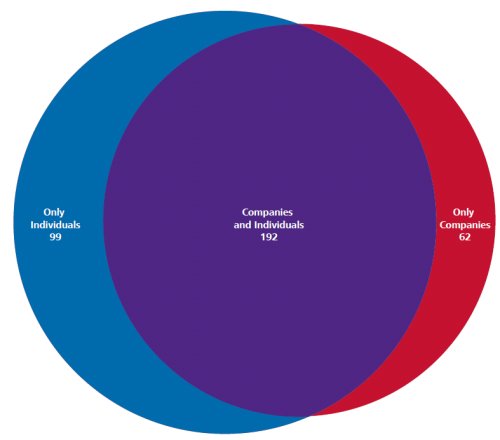
Although allegedly culpable individuals have been historically more likely to be involved in an SEC settlement in misstatement cases than the companies themselves, the company settlement amounts have been much larger. Post-SOX company settlements in these cases total $3.7 billion, compared to $0.6 billion for individuals. Therefore, on an overall basis, companies pick up nearly 87% of the settlement tab.
Although companies have paid more than individuals in aggregate, a comparison of the 10 largest company and individual settlements in misstatement cases (Exhibits 5 and 6) shows that the largest individual settlements are of similar size to large company settlements. Indeed, the $81 million settlement with former HealthSouth CEO Richard Scrushy would rank ninth on the list of company misstatement settlements. The 10th ranked individual settlement, with former Enron Corporation executive Kenneth D. Rice for $14.7 million, would rank 28th if ranked among company settlements.
Exhibit 5. Ten Largest Post-SOX SEC Settlements With Public Companies For Alleged Misstatements
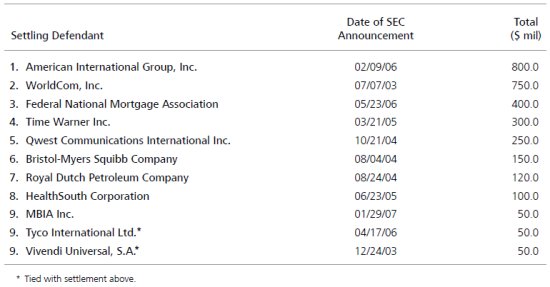
Exhibit 6. Ten Largest Post-SOX SEC Settlements With Individuals for Alleged Public Company Misstatements
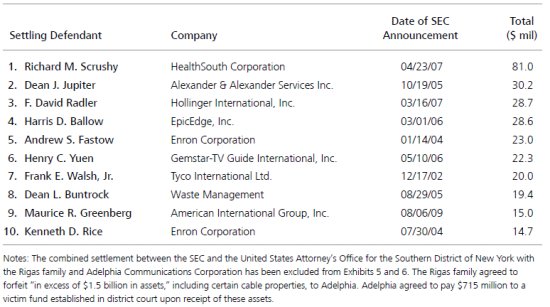
Trends In Public Company Misstatement Cases
The allegations in the Bank of America case are not unusual for an SEC matter. Public company misstatements are among the most frequent allegations in SEC enforcement actions, accounting for 1,013, or 19%, of the 5,362 post-SOX settlements in NERA's proprietary database. Mirroring the trend in overall settlements, the number of settling defendants in public company misstatement cases fell to 121 in FY 2009 from 131 in the prior fiscal year, representing the second straight year of decline (Exhibit 7). Only FY 2006 saw fewer settling defendants in public company misstatement cases.
Exhibit 7. The Number Of Settling Defendants In Misstatement Cases Fell For The Second Straight Fiscal Year
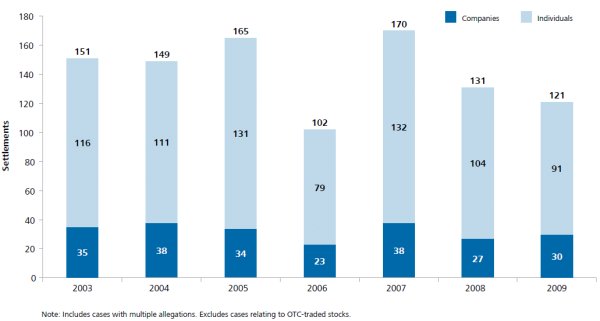
The median company settlement value in misstatement cases also declined, for the third straight year, to $8.0 million (Exhibit 8). The $8.0 million company median was the lowest in any fiscal year since 2003. The median settlement amount for individuals in misstatement cases has ranged from a low of $72,000 in FY 2003 to a high of $120,000 in FY 2007.
Exhibit 8. The Median Company Settlement In Misstatement Cases Continued To Decline
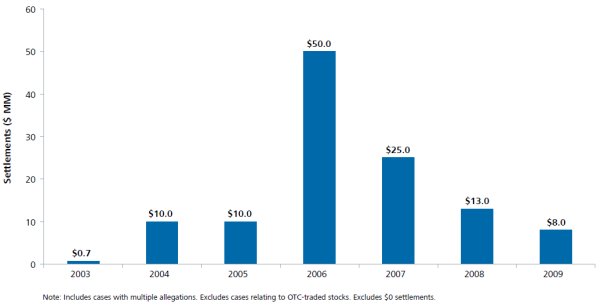
The 2009 decline in public company misstatement settlement amounts occurred despite Mary Schapiro bringing the SEC's penalty pilot program to an end in January. Under the penalty pilot program, instituted under former SEC Chairman Christopher Cox in January 2007, SEC staff members were required to obtain pre-approved settlement ranges from the Commission prior to beginning negotiations with publicly held companies. Ms. Schapiro, citing staff concerns that the program sometimes led to lower corporate penalties than were warranted, announced that she was bringing this program to an end in January 2009.13 However, it is not yet apparent that ending the penalty pilot program has led to an increase in public company misstatement settlement amounts.
The Number Of Insider Trading Settlements Hit A Post-SOX Low
Insider trading is another frequent allegation in SEC enforcement actions, accounting for 570, or 11%, of the post-SOX settlements in NERA's proprietary database. Although the SEC has cracked down on insider trading since the end of the fiscal year by bringing charges in the Galleon case and sending at least three dozen subpoenas to hedge funds and brokerages,14 there were fewer insider trading settlements in FY 2009 than in any full fiscal year since the passage of SOX (Exhibit 9). Fifty-six individuals settled in insider trading cases, compared to 76 in the prior fiscal year. Although the number of settling companies in insider trading cases reached a post-SOX high of 10, seven of these settlements were with entities related to Gryphon Partners. The Gryphon Partners entities were alleged to have engaged in insider trading in connection with certain PIPE offerings.15
Exhibit 9. The SEC Reached Fewer Insider Trading Settlements In FY09 Than In Any Fiscal Year Since SOX
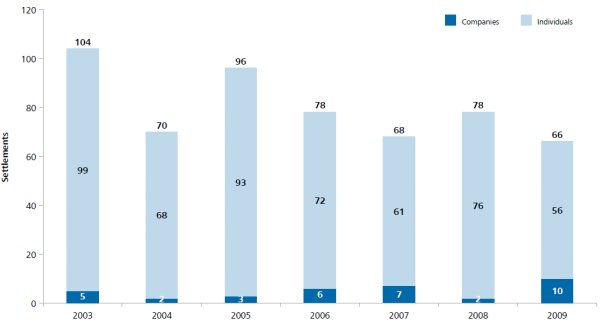
The median settlement amount for individuals in insider trading cases also fell in 2009, to $0.10 million from $0.14 million in FY 2008 (Exhibit 10). Penalties in these cases are limited to three times the gain realized or loss avoided as a result of the insider trading, so these trends are driven both by the size of the implicated trades as well as the punitive stance of the SEC and the courts.
Over the full period of FY 2003 to FY 2009, the median insider trading settlement for companies was $0.1 million, while the mean was $0.4 million. The trends in the annual settlement amounts may be less meaningful for companies, because of the small number of such settlements in each year.
Exhibit 10. After Four Years Of Steady Increase, The Median Settlement Amount With Individuals In Insider Trading Cases Fell In FY 2009
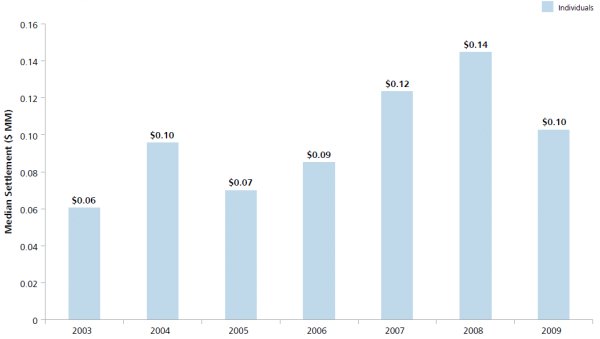
Conclusion
Fiscal year 2009 brought substantial changes to the SEC, in both leadership and its enforcement process. Mary Schapiro replaced Christopher Cox as Chairman of the agency, and Robert Khuzami took over as the Director of Enforcement. Under new leadership, the SEC has enacted several reforms to its enforcement process. The penalty pilot program, which required SEC staff to obtain pre-approved settlement ranges from the Commission before negotiating with public companies, was brought to an end.16 Ms. Schapiro has streamlined the process by which SEC staff obtain formal orders of investigation, in an effort to speed up the investigative process.17
A number of additional reforms have been proposed that could strengthen enforcement activity. As a result of fallout from the Madoff matter, the SEC is seeking authority to reward whistleblowers in cases involving any violations of the securities laws.18 The agency is also seeking penalty authority against aiders and abettors under the Investment Advisors Act.19 Finally, the Department of the Treasury's report "Financial Regulatory Reform—A New Foundation" recommended several reforms directly impacting the SEC's powers, including stronger SEC regulation of hedge funds and credit rating agencies, SEC authority to require that compensation committees of public companies are more independent, and harmonization of SEC and CFTC regulation of securities and futures.20 However, the Bank of America case will also test the SEC's powers. The SEC suffered a defeat when Judge Jed Rakoff rejected the $33 million settlement it had reached with Bank of America Corporation and called for a trial, which is set for February 2010.
Because of the time that it takes for an investigation to become an enforcement action and settlement, the full impact of the reforms already implemented is likely yet to be seen. We will continue monitoring trends in SEC settlements and enforcement-related policy changes in this series of quarterly reports. For additional information and previous reports, please visit www.SecuritiesLitigationTrends.com.
Footnotes
* Mr. Larsen is a Consultant at NERA; Dr. Buckberg is a Senior Vice President at NERA; and Dr. Lev is the Director of the Vincent C. Ross Institute of Accounting Research and the Philip Bardes Professor of Accounting and Finance at New York University Stern School of Business, and a Special Consultant to NERA. The authors thank Ashley Hartman and Eric Schmitt for excellent research assistance and Paul Hinton for valuable comments and suggestions.
1. There are certain types of settlements that do not meet the criteria for inclusion in our analysis. These include settlements relating to failure to file periodic financial statements with the SEC, administrative proceedings barring accountants because of felony convictions, and administrative proceedings barring brokers, dealers, and accountants for practicing while unregistered.
2. For the full fiscal year, there were a total of 22 settlements of $10 million or more, including six settlements of $50 million or more.
3. "SEC Charges General Electric With Accounting Fraud," SEC Litigation Release, August 4, 2009.
4. "Federal Court Grants Summary Judgment and Orders Principals of Offering Fraud to Pay Disgorgement and Civil Penalties of Over $30 million," SEC Litigation Release, July 9, 2009. Hendrix Montecastro is jointly and severally liable for $27.5 million of the $29.8 million award against James Duncan.
5. While this award is a summary judgment and not a settlement, we use the word "settlement" to describe the resolution of any SEC enforcement action because the vast majority of enforcement actions are resolved this way.
6. For example, 38% of enforcement actions opened in fiscal year 2008 were the result of investigations opened more than two years earlier. 2008 Performance and Accountability Report, US Securities and Exchange Commission, p. 31.
7. Memorandum Order, Securities and Exchange Commission v. Bank of America Corporation, 09 Civ. 6829 (JSR), September 14, 2009.
8. According to Judge Rakoff's order, the SEC claims that lawyers for Bank of America are responsible for the alleged misstatement. In his order, Judge Rakoff asked, "Why are the penalties not then sought from the lawyers?" Ibid.
9. "Statement of the Securities and Exchange Commission Concerning Financial Penalties," SEC press release, January 4, 2006. As discussed in the press release, the origin of this idea is in the Senate Committee on Banking, Housing and Urban Affairs report on the 1990 Securities Enforcement Remedies and Penny Stock Reform Act (the "Remedies Act"), which expanded the SEC's authority to seek monetary civil penalties. Prior to the Remedies Act, the SEC could only seek monetary civil penalties in insider trading cases.
10. This figure includes only companies that were traded on national exchanges at the time the alleged misstatement was operative.
11. These 192 cases include 24 in which the company settled pre-SOX and at least one in which the individual settled post-SOX.
12. The total number of individuals that have settled in public company misstatement cases since SOX is 699.
13. Mary Schapiro, "Address to Practising Law Institute's 'SEC Speaks in 2009' Program," February 6, 2009 (http://www.sec.gov/news/speech/2009/spch020609mls.htm).
14. US Securities and Exchange Commission. Litigation Release No. 21255. October 16, 2009. http://www.sec.gov/litigation/litreleases/2009/lr21255.htm; US Securities and Exchange Commission. Litigation Release No. 21284. November 5, 2009. http://www.sec.gov/litigation/litreleases/2009/lr21284.htm; Scannell, Kara and Jenny Strasburg. "SEC Steps Up Insider-Trading Probes." The Wall Street Journal. December 3, 2009: 023.
15. "Edwin B. Lyon, IV and the Affiliated Gryphon Funds Ordered to Pay $778,016 to Settle PIPE-Related Securities Fraud Charges," SEC Litigation Release, August 12, 2009.
16. Mary Schapiro, "Address to Practising Law Institute's 'SEC Speaks in 2009' Program," February 6, 2009 (http://www.sec.gov/news/speech/2009/spch020609mls.htm).
17. Robert Khuzami, "Testimony Concerning Strengthening the SEC's Vital Enforcement Responsibilities," May 7, 2009 (http://www.sec.gov/news/testimony/2009/ts050709rsk.htm).
18. Ibid.
19. Ibid.
20. "Financial Regulatory Reform––A New Foundation," Department of the Treasury, June 17, 2009.
The content of this article is intended to provide a general guide to the subject matter. Specialist advice should be sought about your specific circumstances.

